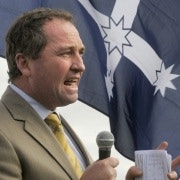Bligh's convenient funds truce
Queensland Labor enters the 2012 election without one of its key campaigning tools of recent years, the ability to massively outspend its opponents.
The Bligh government's 2011 changes to political donation and expenditure laws have capped electoral expenditure since May 2011. Queensland Labor's success over the past four elections has been built on the ability to out-fundraise and outspend the conservative parties, often on a massive scale, Australian Electoral Commission data shows.
But, just as the same fate may have been inflicted on Labor, the new laws will cruel a revitalised LNP that would have benefited under the old rules from Campbell Newman's ability to generate funds in south-eastern Queensland.
Using party expenditure as a rough proxy for campaign spending, the data shows Queensland Labor has consistently outspent the conservative parties in election years. In 2001, it spent $8.3 million compared to a combined total of $5.6 million for the Nationals and Liberals. In 2004, it more than doubled the conservatives' spending, $14.1 million to $6.6 million. In 2006, it simply blew the conservatives away, spending $16.7 million to $7.7 million.
At that stage, Queensland Labor was behind only the federal party and the NSW branch in spending, and it was fuelled by a massive fundraising effort that saw revenue peak at $17.4 million in 2006.
The 2009 election was fought against a unified Liberal National Party for the first time, and it made a significant difference: the LNP lifted its fundraising and pulled in more than $12 million that year, and spent $11.5 million. But Labor still outmatched them, spending more than $14 million to achieve a win for Anna Bligh.
Bligh's subsequent reforms to donation and expenditure laws were driven by a series of lobbying scandals, but they dovetailed neatly with the campaign by Campbell Newman for the premiership from outside the parliament. With the LNP now headed, at least notionally, by a Brisbane politician, the LNP could have expected to generate a significant increase in donations under the old rules and at last responded in kind to Labor's electoral carpet-bombing.
The reforms capped political donations at $5000, but the cap only applies to donations made during election campaigns (after the issue of writs) or explicitly for campaign purposes; donations outside the campaigning period aren't capped. Expenditure caps also apply, from well before the election officially begins, and caps have been in place since May last year. There are also caps on third party expenditure.
The Coalition complains that the changes favour Labor's financial links with trade unions, but the expenditure caps will also play a big role: notionally, neither side will be able to exploit any advantage in fundraising. This has almost certainly deprived the LNP of some of the benefits of Newman's leadership, especially compared to that of Lawrence Springborg, who struggled to appeal in Brisbane.
The AEC data suggests only a nebulous connection between outspending your opponent and winning elections. A US study suggests that, despite popular belief, election spending had little impact on the outcome of congressional races, but that's not particularly comparable to state and federal elections in a compulsory voting system like ours. According to the data – bearing in mind it's only a proxy for campaign spending – 10 of 31 elections since the 1999 NSW election have been won by the party spending less money than its opponents in election years.
That includes Steve Bracks snatching minority government from Jeff Kennett despite Labor spending $6.7 million to the Liberals' $10.1 million (Victorian Labor was outspent in 2002 as well, but thumped the Liberals), and Ted Baillieu narrowly defeating John Brumby despite Labor spending nearly $3 million more than the Liberals in 2010.
In WA, Labor has always been outspent by the Liberals, but managed to win in 2001 and 2005, but lost in 2008 when it nearly closed the spending gap, spending $5 million to the Liberals' $5.9 million.
But only in Queensland has there been such a big gap between party fundraising and spending, one that was finally remedied by the Liberal and National parties agreeing to merge. No other contest elsewhere in Australia ever saw such big differences in spending, except one: the 2007 federal election, where Labor massively outspent the Liberals, $60.9 million to $37.8 million, reflecting a similarly massive gap in fundraising between the parties, with Labor reaping the excitement of Kevin 07 and union desperation to end WorkChoices.
In 2010, in contrast, Labor and Liberal federally raised similar amounts and spent similar amounts to come out with a hung parliament.
This story first appeared on www.crikey.com.au on February 22. Republished with permission.













